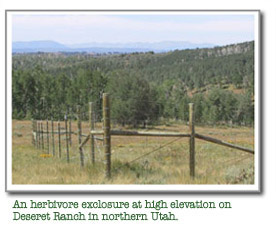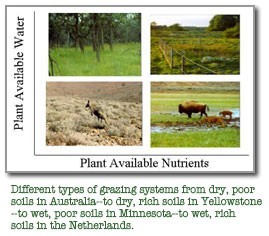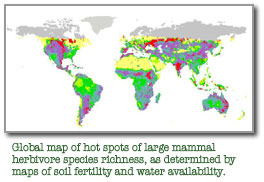Grazer-plant interactions across rainfall and soil fertility gradients

Over 50% of the earth’s land surface is managed for herbivory by mammals, either wild and/or domestic. This herbivory threatens plant diversity and ecosystem productivity or is itself threatened by expected changes in climate, atmosphere, and urban and agricultural land use. However, little synthesis has emerged despite literally hundreds of studies of mammalian herbivore effects on grassland plant communities.
 The next phase of this project will complete and intensively sample an existing large-scale field experiment that independently manipulates water and nutrient supply to multiple plant species in 64 large (450 m2) plots undergoing secondary succession. This experiment will directly test predictions about how plant resources influence terrestrial plant communities and the impact of herbivores on these communities. The objective is to construct herbivore exclosures in each plot and measure soil water, nutrient supply rates, and plant species composition and diversity in response to different rates of water and nutrient addition. Preliminary results suggest that production is co-limited by water and nutrients, and plant species are most abundant at ratios of water and nutrient supply that match their use of carbon and nitrogen for growth and herbivore defense.
The next phase of this project will complete and intensively sample an existing large-scale field experiment that independently manipulates water and nutrient supply to multiple plant species in 64 large (450 m2) plots undergoing secondary succession. This experiment will directly test predictions about how plant resources influence terrestrial plant communities and the impact of herbivores on these communities. The objective is to construct herbivore exclosures in each plot and measure soil water, nutrient supply rates, and plant species composition and diversity in response to different rates of water and nutrient addition. Preliminary results suggest that production is co-limited by water and nutrients, and plant species are most abundant at ratios of water and nutrient supply that match their use of carbon and nitrogen for growth and herbivore defense.
 In an ongoing cross-site study funded by NSF, I work in collaboration with 3 other scientists and several graduate students to develop new, more synthetic hypotheses about how mammalian herbivores of different size might affect grassland plant species composition and diversity, and therefore ecosystem nutrient cycling and primary productivity. Specifically, we predict how herbivores of different size affected plants and nutrient cycling across sites that differ in productivity, water availability, and soil fertility (Olff and Ritchie 1998, Ritchie et al. 1998, Ritchie and Olff 1999, Olff, Ritchie, and Prins 2002). We address these hypotheses in a collaborative cross-site experimentof the effects of different-sized herbivores on grassland plant species composition, diversity, production and nitrogen cycling. This study features a common experiment at nine sites that varied ten-fold in productivity, including three sites of different elevation in Utah (Deseret Ranch), and one each in South Dakota (Badlands National Park), Colorado (Shortgrass Steppe LTER), Kansas (Konza LTER), Minnesota (Cedar Creek LTER), and a river floodplain grassland in the Netherlands (Junner Koeland). Results thus far support the hypothesis that grazing by diverse grazer communities enhances plant diversity primarily at sites with high productivity. This effect was primarily due to effects of large grazers, which increased plant species richness at high and low productivity, but decreased it at intermediate productivity.
In an ongoing cross-site study funded by NSF, I work in collaboration with 3 other scientists and several graduate students to develop new, more synthetic hypotheses about how mammalian herbivores of different size might affect grassland plant species composition and diversity, and therefore ecosystem nutrient cycling and primary productivity. Specifically, we predict how herbivores of different size affected plants and nutrient cycling across sites that differ in productivity, water availability, and soil fertility (Olff and Ritchie 1998, Ritchie et al. 1998, Ritchie and Olff 1999, Olff, Ritchie, and Prins 2002). We address these hypotheses in a collaborative cross-site experimentof the effects of different-sized herbivores on grassland plant species composition, diversity, production and nitrogen cycling. This study features a common experiment at nine sites that varied ten-fold in productivity, including three sites of different elevation in Utah (Deseret Ranch), and one each in South Dakota (Badlands National Park), Colorado (Shortgrass Steppe LTER), Kansas (Konza LTER), Minnesota (Cedar Creek LTER), and a river floodplain grassland in the Netherlands (Junner Koeland). Results thus far support the hypothesis that grazing by diverse grazer communities enhances plant diversity primarily at sites with high productivity. This effect was primarily due to effects of large grazers, which increased plant species richness at high and low productivity, but decreased it at intermediate productivity.
Selected Related Publications:
Olff, H., M.E. Ritchie, and H.H.T. Prins. 2002. Global determinants of diversity in large herbivores. Nature415: 901-904.
Knops, J. M. H., M.E. Ritchie and D. Tilman. 2000. The effect of selective herbivory on a nitrogen fixing legume (Lathyrus venosus) on productivity and ecosystem nitrogen pools of an oak savanna. Ecoscience 7: 166-174.
Ritchie, M.E. and Olff, H. 1999. Herbivore diversity and plant dynamics: compensatory vs. additive effects. Pages 175-204 In: Olff, H., Brown, V.K., and Drent, R. (eds.). Herbivores: Between Plants and Predators. Blackwell, Oxford, UK.
Ritchie, M.E., D.Tilman, and J.M.H. Knops. 1998. Herbivore effects on plant and nitrogen dynamics in oak savanna. Ecology 79: 165-177.
Olff, H., and Ritchie, M.E. 1998. Herbivore effects on grassland plant diversity. Trends in Ecology and Evolution, 13: 261-265.
